| |
|
|
 |
|
| A difficult way to be different |
|
|
|
|
|
|
| |
|
|
|
|
|
|
|
|
|
|
| |
|
|
|
|
|
|
|
|
|
|
| |
|
by Gigi Scarpa |
|
|
|
|
|
|
| |
|
|
|
|
|
|
|
|
|
|
| |
|
Perhaps it was through Costantini that
once I realised, as I observed a print by a French impressionist, that
if that painting had value, and not only of a historical kind, then
also some works by that recently discovered Venetian painter, were
certainly no less valid, or less meaningful. In fact they seemed better.
Neither was the present contestation, that his works were perhaps “out
of step”, “not in tune with the culture of the moment”,
or “without information” valid; in fact, the opposite was
true; they were new and alive and a part of the structured journey
he began as he embarked upon his art career following his artistic
training at school, which he had completed with great fondness and
enthusiasm. It was a school which was still capable of its true function: ‘to
nurture a vocation’ by providing the necessary technical, practical
and human notions, essential to guide an intelligent, confident and
gifted young man on his artistic journey.
After he left school and following the long pause due to the war,
Costantini was able to harmonise what he had up until then learned
and experienced to form the art he wanted to create, the family that
he wanted to found on a clear principles of humility and a strong faith
based on an inner spiritual training which was declaredly Christian,
and to continue his teaching at school through which he supported the
household and which therefore provided him greater freedom for his
painting.
I am writing all this because, nowadays, such a clearly focused and
harmonious life has become almost an exception, amongst the many difficulties
and existential battles and conflicts of painting within a form or
a point of view which by general assent but also superficially (if
not stupidly) one might call ‘bourgeois’. And yet it is
all too easy (sometimes) to play the anti-bourgeois part, by searching
amongst the disorder, or inside the artifices, for presumed absolute
liberties or at least inspirations, or better, for some excitement,
even if possibly – or without possibly – these may become
rich and fertile experiences. But to remain within the natural limits
of a clear and traditional ‘humanism’ can be, and sometimes
is, in addition to being wise, is truly courageous as well.
If then I delve deep enough into the history of art I understand that
such a bourgeois approach provided the substance of the immense wealth
not only of the anonymous painters of the early middle ages, but certainly
also of the greats of successive centuries (from Giotto to Tiepolo)
on and on, at least up until the most revolutionary romanticism. How
many times Ernani would repeat to me, during our attentive brotherly
conversations, on encountering the latest examples of contemporary
painting, how convenient it would have been (and how easy it was) to
make use of an imitation, to absorb others’ motifs, rid oneself
of the real, follow a fashion and no longer be ourselves; and not do
it on the other hand because one was influenced by the greatness and
power, let’s say, of Cézanne or Modigliani, of Picasso
and Mondrian and in what they stood for; so that, then, these greats
would have been truly loved and understood.
In the end, I am left with an almost rhetorical but nonetheless valid
quotation: we must obey the ancient teaching “know yourself” in
order to really be ‘ourselves’. Ernani Costantini has remained
faithful to this knowledge, without fear of being isolated, or perhaps
with some fear but without compromise, also in his native city of Venice,
and has sometimes been forgotten or underestimated. But fortunately,
always free. It is for this reason that for me it is so very special
to write about him once more, even though far away, as I did the first
time in 1954, now that he has been working for nearly thirty years,
and today he wishes to re-examine, re-consider and evaluate a lifetime
and its activity which may serve him as an incentive to continue and
the certainty of not having betrayed the enthusiasms and passions of
his poignant and magnificent vocation. |
|
|
| |
|
|
|
|
|
|
|
|
|
|
| |
|
But where does Ernani find his inspiration?
Where does his poetic world come from? And, might we add, what are
the objectives of his painting? After a first brief interlude outside
the school walls, an intense anxiety about reality gives rise to his ‘notes
of life’ which appear around us regularly in the news, at the
cinema, in advertising. He participates in these current events (or
modernity) through his early works, accompanied by his developing passion
for more recent music, consolidated by that more hidden and fonder
passion for the classical; from jazz to Bach, from Mozart to Debussy,
providing specific sources of inspiration.
However, another more personal element was to appear, that is to say ‘Ernani’s
painting’. An intimate and delicate world, recreated through
the study of still life, interiors, and transcriptions of the best-known
and most intimately adored poetry: the poets of the thirteenth century
and Montale, Dos Passos and Eliot are the authors he preferred at that
time, whose works he knew by heart and which he would often enjoy.
This constant feature was to form a basis for all his work, his research
and his production, dominated by that interiority and religious presence
equally evident and clear in those works with a ‘sacred’ theme,
which constitute a particularly remarkable and high level nucleus of
his now twenty-year artistic career. And on this path, which may have
an undulating shape of high and low points (all artists are familiar
with these: quandoque bonus dormitat Homerus) I will try to highlight
the various moments, stages, revivals and openings. |
|
|
| |
|
|
|
|
|
|
|
|
|
|
| |
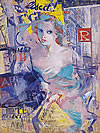 |
| |
|
| The Newspaper Seller,
1954 |
 |
 |
|
|
If his first satisfaction was that of being
selected for the 1954 Marzotto Prize with The
Newspaper Seller with
its paint still wet, without a shadow of doubt an even more notable
result awaited him with the completion of Cafè in Rapallo, one
of the most beautiful and important works not only by Ernani, but,
I genuinely believe, of the entire city of Venice, at that time, at
least among the younger artists. Perhaps it was unique. Despite being
unknown, this great canvas of 1953/54 enshrined and opened up a distinctive ‘Costantini
mode’.
This is constructed through its composition with an intuitive
freedom such as for example that of cubism, or even art nouveau, within
a drawing completely imbued with colour, which has an extraordinary
delicacy and flavour which recalls Eugenio Montale: the ‘lady’ in
the foreground displays a rich poetic and sentimental languor and an
elegance of that period as her solitude contrasts with the cheerful
band of mischievous children playing their makeshift instruments. |
|
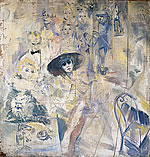 |
|
Café in Rapallo, 1954 |
| |
|
|
|
|
|
|
|
|
|
|
| |
|
The following year he painted the Mother
and Child which is absolutely worthy of a Picasso style ‘classicism’,
strong and secure in its design, enveloped in a grey-pink tone which
locks it into an interiority which at the same time expresses love
and pain, until, dare I say, rare heights are reached in an exceptional
formal and sculptural unity.
Just as the early ‘portraits’ show a fresh and secure ability
to render a precise reality, with an agility of cut and layout which
is still remarkable and enduring.
In the Portrait of G.S. the curious stripes of the jacket and the oblique
lines of the limbs in the pose are typical formal elements like the
way the figure is contrasted against the background of a delicate pink
and balanced by the browns of the volumetric foreground. |
|
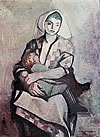 |
|
|
|
Mother and Child, 1955 |
| |
|
|
|
|
|
|
|
|
|
|
| |
|
At the same time the necessary and natural ‘discovery’ of
the most important contemporary painters – from Kokoschka, which
he used in the ‘landscape’, to Picasso and Braque who set
him off on the task of renewing his ‘still life’ paintings – offered
him a way of freeing himself from the constraints of depicting the
real, and of being involved with experiences which were ‘non
figurative’, to explore a new and totally personal lyrical reality,
interpreting varied themes inspired by or taken from music – (and
Toccata and fugue is a complete painting, precise and vibrant; and
St. Mark’s is of course present, but transfigured, in the golden
light, into an explosive and unitary song) – or suggested by
poetry (and The reading unites space and time in a rare harmony of
colour, with immediate force and robust synthesis) – or from
architecture (and the transfiguration of the interior of Taliesin
West remains one of his most important and significant paintings, both for
its tone and light, and its poetic recreation of the crudely photographic
detail, achieving a feeling and an atmosphere filled with exquisite
and soulful resonances). |
|
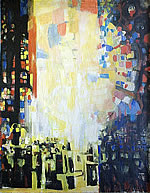 |
|
Toccata and fugue, 1957 |
| |
|
|
|
|
|
|
|
|
|
|
| |
|
They are works which, with other interpretations
of the real and of nature (some free constructions of ‘ficus’ were,
for a time, a recurrent and much-favoured theme) were to become ‘typical’ themes
or subjects for Ernani, towards a definement which is never a signature
or a formula, but a fresh approach which gives nature and reality (objects,
landscapes or people) that light which is pulsation and movement, space
and time; a soul, through which the painting is natural and fantastic,
real and abstract, order and freedom.
I remember a Ficus from 1957 constructed leaf on leaf in an architectural
ascension, almost a stairway (like the one in nature which makes leaves
grow on a twig), yet continuously gentle thanks to the precise movement
of light, which gave substance and strength to the hard leaf of elegant
plant and which together preserved its splendour and shape. A painting
based on a somehow cubist lesson, without ever losing its truth and
spontaneity, with no sign of a plan or any imitation, and which is
able to conserve, truth to life, a new order of rhythm and colour,
of strength and light, to reach, uniquely, a free but personal form
which was (and is) his value. |
|
|
| |
|
|
|
|
|
|
|
|
|
|
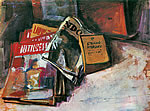 |
| |
Strange Interlude, 1954 |
|
|
Thus I would like to define a few of Ernani’s
most important ‘pages’, which have included Composition
with newspapers completely in blue, Death
in the afternoon (variation
in the cubist style of the older Strange Interlude), Homage
to Dos Passos and lots of his ‘still life’ studies,
up to and including the most recent ones which he managed to grant
through the use of a kind of translucent light a depth of space which
renders their colour and design in a new type of composition and where,
the inspiration, which one might describe as of far-eastern derivation,
is now dominated in an absolute inner originality, which no longer
allows for the citing of sources. Among these latest paintings the
best, in my opinion, despite their simplicity and apparent directness,
are The
Olive, A few potatoes and The
clementines. While without fear and with an effort which is
moral as well as ideal – and even controversial in a world with
whose dramatic and violent nature Ernani is all too familiar, as well
as the anxiety of renewal and the revolutionary utopia, it is for this
reason that he aims to bring to it the joy of colour, light and nature
(a joy which for him, as for me, is a gift of peace, hope, and certainty) – with
this task Ernani returns to the portrait, the nude, from which an equal
serenity and joy may be gleaned. But sometimes instilling an inner
anxiety which animates the character, like in that nude on the pink
background, which gives the startled nakedness of the woman in the
huge space surrounding her, a painful weight despite the broad balance
within. |
|
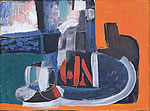 |
|
Homage to Dos Passos, 1958
|
| |
|
|
|
|
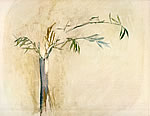 |
|
The Olive, 1968 |
| |
|
|
|
|
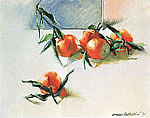 |
|
The clementines, 1971 |
 |
 |
 |
 |
 |
|
| |
|
|
|
|
|
|
|
|
|
|
 |
 |
 |
 |
 |
 |
 |
 |
 |
 |
 |
| |
|
To underline then, not separately, but
with a certain distinction, how much Ernani has given and produced
in the field of the ‘religious subject’, is, it seems
to me, an exception to write. And I wrote ‘religious subject’,
because in a certain, even ‘romantic’ sense, all art
is sacred, but particularly for him, precisely because of how he
renders every work sacred almost like an offering to God, before
all others, as a recognition of His creation and its splendour.
He
tries to maintain that sacred feeling even with the most difficult
(perhaps) ‘religious subjects’, so often fallen by the
way due to being drawn from the long tradition of religious art which
is so ‘exemplary’ and secure in its history.
And it is
a typical ‘story’ in the painter’s journey, which
reveals his efforts and his courage and, without a doubt, as his
work is more freely commissioned and accepted, its religious character
appears all the stronger, so rich and original in its production
and, so much more valid its contribution also to the religious education
of the population, becoming, as it did, also an ‘education
in art’. |
|
|
| |
|
|
|
|
|
|
|
|
|
|
| |
|
He begins with the ‘adventure’ of
St. Joseph who should have remained in humble silence at
the church of Madonna dell’Orto and who encountered, instead, vacuous opposition in a misunderstood
and false respect of the past. It was indeed a logically composed
painting, assembled naturally according to accurate and current criteria,
with the freedom of colour and composition. It nevertheless
revealed a continuity typical of the traditional ‘altarpiece’ (the
saint in the foreground and scenes from his
life in the background) within current expressive forms. Perhaps we
might have discussed the unity between a certain imposed naturalism
reflected on the face of St. Joseph (a young man with a
restless child in his arms at last) and the episodes in the background,
more freely invented, even reaching a certain ‘abstraction’.
It remained however a laudable work, thanks to its order and efficiency,
exquisite detail, including even some ‘antique’ elements,
such as the carpenter’s tools, one might say, almost reminiscent
of Tintoretto. |
|
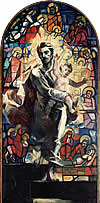 |
|
|
|
St. Joseph and the Christ Child,
1955, Costantino Institute, Mirano (Venice) |
| |
|
|
|
|
|
|
|
|
|
|
| |
|
I would also like to recall a Way
of the Cross (now housed in the church of the Seminary in San Vito di
Cadore) which Ernani painted some time later, with its abstract and
symbolic drawings, modulated by greys and violets, one might say
as preparation for the one in the church of San Canciano (similar
to that of the Cavanis Fathers, formerly in
the A.C. collection)
organized into fitting tercets using four fundamental and expressive
tones: pink-red, golden yellow, violet, grey and black, which can
be easily interpreted as symbols of condemnation, love, and melancholy,
leading to the darkness of the sepulchre.
Then there was the large Crucifixion (now in Reane in Auronzo) and
the words I wrote about it in 1957 and which I would like to repeat
here still seem appropriate: “… with the other figures
and Mary Magdalene so clear in construction and in colour and so
secure in her still current form, and her space within precise geometric
ratios, the altarpiece … shows the painter’s urgency
to follow, in a free and personal way, the simplifying architectural
lesson of a specific abstract art”.
The painting was prepared using ‘notes’ and studies of
different Crucifixes, including the Pietà of the house of
M.C., so essential, so severe and at the same time so delicate. Above
all, like the altarpiece, without a rhetoric of movements or colours,
but, like that and more, enclosed in the monochrome expression of
never-ending pain. Also deserving of mention here is the small Sacred
Heart in my possession in which Ernani was finally able to break
with the physical sentimentalism of this very demanding theme by
painting a single drop of blood and a few thorns which are hinted
at rather than clearly defined on the gold background which ennobles
it. |
|
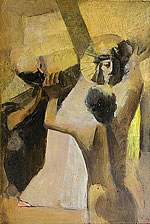 |
|
Way of the Cross, 5th station, abt
1956,
church of San Canciano, Venice |
| |
|
|
|
|
|
|
|
|
|
|
| |
|
The period between ‘64 and ‘68
was dominated by the great mural compositions in the churches of
Sacca Fisola in Venice, Altobello and Bissuola in Mestre, Venice,
and Sant’Agnese also in Venice. Works which kept the painter
busy for months at a time, from the early preparative and conceptual
stages, to the laying down of the sketches in the studio, and the
deliberation of compositional solutions – certainly not
easy due to obligations imposed by the architecture – before
he attacked the enormous surfaces of the bare walls with gusto but
also with some trepidation.
Used, as we are, to paintings done on easels, always of modest proportions,
we might have expected that some of the painter’s most distinctive
characteristics and some unique and original qualities – the
freshness and luminosity, the mobility of spaces and the links between
levels and volumes through light – would be lost in such large
scale compositions. In fact, on closer inspection, these works display
an equal touch, equal lyricism, and equal spirit. It is sufficient
to re-examine amid the vastness of each composition and its movement,
the main idea represented, slowly savour its ‘moments’ and
then all his old and future paintings may be seen once more.
|
|
|
| |
|
|
|
|
|
|
|
|
|
|
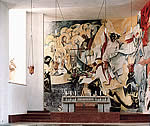 |
| |
Resurrection of Christ
and Communion of Saints 1964, San Gerardo Sagredo, Venice |
|
|
In the Resurrection of Sacca
Fisola the
composition is highlighted by the ascent of the group of Saints on
the left, with exquisite detail, towards the enormous Christ figure
and by their descent towards the characters of ‘our time’ (among
which Ernani also wanted to include Chaplin as a provider of joy). The series includes some idealised but also
realistic portraits
which are quite indicative of the artist’s thoughts in a renewed ‘anachronism’ – which
was such a fondly and frequently used device among the master painters
of old. |
|
|
|
|
|
|
| |
|
|
|
|
|
|
|
|
|
| |
I followed the creation of the Stories
of the Virgin Mary in Mestre (the Virgin soaring with passion
and enthusiasm like the Happy Bride by Arturo Martini) quite closely
during the complex vortex of its composition, obliged by the curved
shape and the windows of the chapel, and I realise the significance
of the research into this broad synthesis (on such a large scale)
of figures in the light which forms them and keeps them suspended
and happy in the air. Perhaps the work San Girolamo Emiliani in
the same church may be considered even more successful, thanks to
the variety of episodes, which helped resolve the problem of space
and of composition, with the greater motion of the varied colours,
thus emphasizing anthological details (the ‘infected’ – linked
to tragic moments both recent and contemporary – the lovely
landscape of Quero, accurate and life like). We repeated how pertinent
and precise the insertion of written phrases was, “as done
by the ancients”. |
|
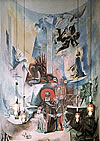 |
|
|
|
Life of St. Girolamo Emiliani,
1966, church of Cuore Immacolato di Maria, Mestre, Venice |
| |
|
|
|
|
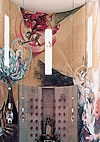 |
|
|
|
Stories of the Virgin Mary, 1968,
church of Cuore Immacolato di Maria, Mestre, Venice |
| |
|
|
|
|
 |
 |
 |
 |
 |
|
| |
|
|
|
|
|
|
|
|
|
|
| |
|
|
|
|
|
|
|
|
|
|
The Last Supper, 1968
church of Sant’Agnese, Venezia |
|
 |
|
|
|
|
|
|
| |
|
|
|
|
|
|
|
|
|
|
| |
|
|
|
|
|
|
|
|
|
|
| |
|
In contrast, the horizontal and almost
frontal composition of the Last Supper in the church of Sant’Agnese
is more traditional. To me as I contested him by warning of the risk
of being too ‘classic’ (which he isn’t) and bound
by an expression in the manner of Andrea del Castagno or Raphael – unrepeatable – Ernani
replied knowingly: “Should I perhaps be afraid? I am not afraid
if with my Apostles and Christ some people think they can use those
distant models against me. For centuries the Supper has been painted
like that, new every time, despite everything, … but I have
also been able to free myself of those patterns, as in the one you
are familiar with, centered around the circular table, in Bissuola”.
(And I know – he meant to say – and I try today, through
my freedom and my craft and above all my personal effort, to imagine
and create a Eucharistic Christ, the Apostles with their various
different faces – and also the same amazing and moving faith
even in Judas.) |
|
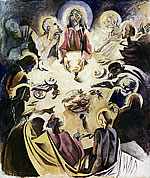 |
|
The Last Supper, 1967, church of Santa Maria della Pace,
Mestre, Venice |
| |
|
|
|
|
|
|
|
|
|
|
 |
 |
 |
 |
 |
 |
 |
 |
 |
 |
 |
| |
|
And among these works were some more
intimate ones, with a deeper exploration of personal, emotional and
sculptural interests always with an ideal religious purpose: The
loaves and the fishes on which a miraculous light descends and
the unfortunate (and poorly understood) Emmaus often, in
the faces, and the contrast of the two fundamental shades of colour,
with its free composition – “are swept along by the winds
of the Holy Spirit” – reminded me
of some details by Rembrandt, even
though indistinct in my memory. |
|
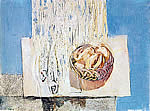 |
|
I pani e i pesci, 1959 |
| |
|
|
|
|
|
|
|
|
|
|
| |
|
Further back in time, I wouldn’t
want to omit, the Annunciation from 1955 with a spectacular Angel
who dominates the light which bathes the space: one of the works
drawn with a very great though very delicate precision, without unexpected
changes of colour.
Seeing that for Ernani drawing (although more concealed and little
known) provides a key to his qualities, especially in the preparation
of ‘themes’, the study of details (I remember those of
the ’lily’ in the afore-mentioned Annunciation, exceptional
in their purity and sculptural-formal substance) and in the compositions,
even if it often comes naturally to him to embark on the painting
by ‘facing it’ directly on the canvas. But there is no
shortage of excellent examples of how the suggestion or the idea
(commissioned or suddenly revealed and felt) are studied, observed
and researched with the most rapid and varied means, the drawing,
which is still a keystone of artistic technique.
The discourse is not finished either, because (as I read a few days
ago) as old Kokoschka said, as he redesigned the Night by Michelangelo, “a true artist must always learn” and
Costantini too would certainly not deny this teaching: one can and
must learn from everything: from the past and the present, from consecrated
art and from everyday life, from nature and from technique and bring
everything into one’s own spirit, make it the body and soul
of one’s own feelings in order to give it back to others, transfigured
by a personal ‘poem’ as a thankful gift.
In this way we may consider other no lesser aspects in order to understand
how Ernani creates his paintings. Alongside technical expertise,
there lies a careful continuous personal study of art (history and
critique) made more alive by his urgency to communicate it to his
pupils every day. How many times have I heard talk of his ‘lessons’ with
methods and themes which reveal his passion, taste, sensibility and
even his emotive reaction when faced with the most spontaneous ‘answers’ from
his students. Just as his own critical work is important, dedicated
to an art form quite closely related to painting, such as the cinema,
which often becomes, in his portraits, in his ‘photograms’ an
opportunity for inspiration and learning sometimes even for himself.
And if in a recent ‘message’ to a group of teachers he
spoke of ‘drawing’ and ‘active gesture’,
I know how true his experience is, because in addition to his drawing,
also gesture (in his youth in the theatre for example) has often
defined his personality.
These are the elements which contribute to produce not only his character
through varied and stimulating experiences, but which form the ultimate
purpose of his life – and it is the first: that of translating
his life into the comforting beauty of painting – “I
want to give joy” are his sincere and revealing words. An
intention that Ernani Costantini is carring out with faith and sacrifice. |
|
|
| |
|
|
|
|
|
|
|
|
|
|
| |
|
|
|
Gigi Scarpa |
|
|
|
|
|
|
| |
|
|
|
Marseille, February 1973 |
|
|
|
|
|
|
| |
|
|
|
|
|
|
|
|
|
|
| |
|
|
|
|
|
|
|
|
|
|
 |
 |
 |
 |
 |
 |
 |
 |
 |
 |
 |
|

